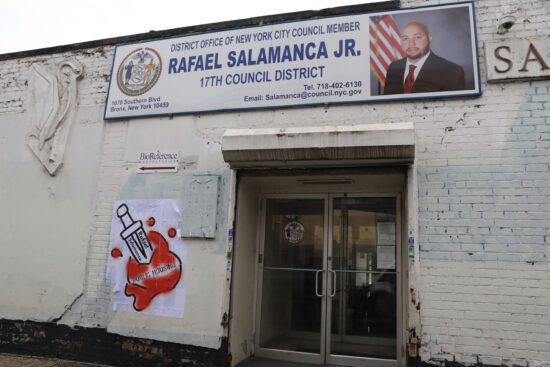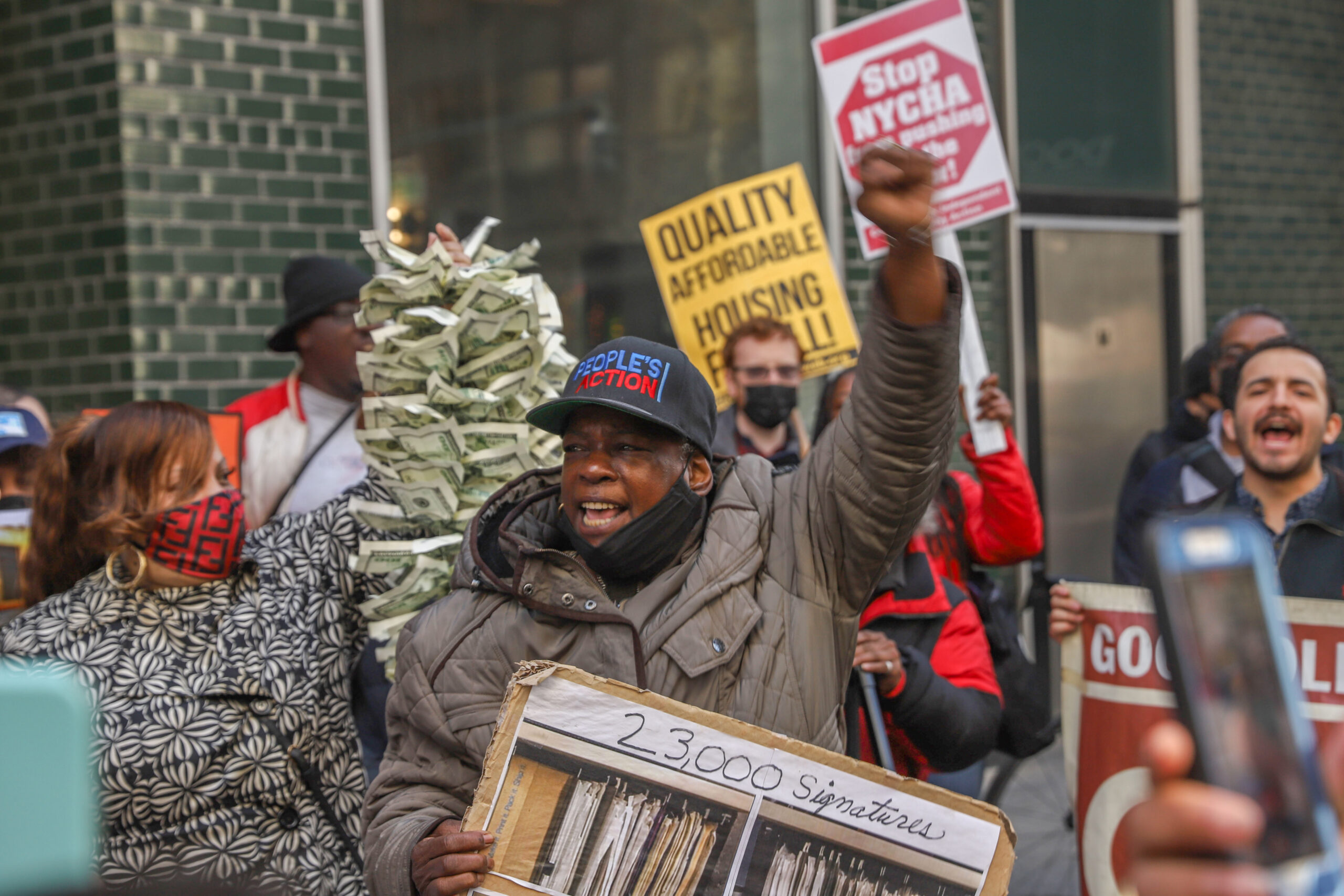Residents and tenant leaders from across the city, including many from the South Bronx, protested at the governor’s office in midtown Manhattan Friday, demanding the state provide $7.2 billion for public housing in its upcoming budget.
Decades of federal disinvestment from public housing has led to miserable living conditions in many NYCHA buildings, with leaks, gas outages, mold, lack of hot water, and broken elevators. Needed repairs will cost $40 billion, according to NYCHA, whose buildings house nearly 400,000 New Yorkers.
The draft state budget, which must be passed by April 1, currently contains just $500 million for NYCHA. However, the Residents to Preserve Public Housing and other advocacy groups are calling for $3.4 billion for capital funds, $2.8 billion for operating funds, a comprehensive spending audit, and $1 billion for public housing elsewhere in the state.
Sarah Blas, a mother from Staten Island, said that four of her six children have chronic, persistent asthma from the mold in her NYCHA complex. Public housing is associated with the highest childhood asthma rates in the city.
“It takes nine months for me to be able to get mold repaired in my apartment,” she said, her voice shaking. “I am sick and tired of having these rallies and these same conversations. These are our babies’ lives.”
At the end of February, NYCHA had over 580,000 open work orders. Meanwhile, the authority says it can handle only about 90,000 per month
Although public housing is primarily funded by the federal government, Washington’s neglect has forced advocates to also turn to the state and city governments for support.
NYCHA’s total revenue in 2021 was just $4.1 billion, including $1 billion from tenants’ rents, $2.4 billion from the federal government, and $248 million from the city. The state also contributed $200 million to the capital budget, but nothing for the operating budget. Washington failed to pass the Build Back Better bill last year, which would have contributed $65 billion in capital funds for public housing across the country.
“I’ve never seen any other group of people who pay their taxes, but have to work so hard just to get funding,” said Princella Jamerson, tenant leader at the Mill Brook Houses in Mott Haven.
Jamerson said that NYCHA residents are often unfairly portrayed as lazy, when most are in fact hard-working taxpayers. Around half of residents are working families, and many are seniors who depend on pensions or social security, according NYCHA. Residents are required to pay one-third of their income in rent.
The first public housing projects in the city were built during the Great Depression and many more followed after World War II, to house mostly white veterans. But as more people of color began moving in over the following decades, the government began to disinvest from public housing — a move that many current residents see as racist.
“It’s always been a racial issue with housing — just like schools, jobs, and elected officials,” said Ronald Topping, tenant leader from the John Adams Houses in Longwood.
NYCHA has been trying to address budget shortfalls through the Rental Assistance Demonstration program and a proposed Blueprint for Change, both of which involve greater collaboration with the private sector.
Under the Rental Assistance Demonstration program, which began in 2015, NYCHA has transferred over 9,500 apartments – about 5% of all units – to private management companies. Residents are given Section 8 housing vouchers to pay rent to the management companies, which are then responsible for undertaking repairs. NYCHA says that Section 8 conversions have helped fund necessary repairs, and do not affect tenants’ rights.
However, many tenants say that private management companies are even less accountable than NYCHA, and Human Rights Watch recently found that conversions led to more evictions in two projects it studied.
Some residents think that by privatizing building management, NYCHA and its CEO, Greg Russ, are headed down a path towards full-scale privatization. They fear this will drive them from their homes and gentrify their neighborhoods.
Patricia Woodall, a long-time resident of St. Mary’s Houses in Mott Haven, is worried about the upcoming conversion of her building to Section 8. She was told that she would have to move out of her apartment while renovations are underway.
“What they say is they want to beautify St. Mary’s, but once everything is beautified, and the apartments are renovated, they’re not going to want us to come back!” Woodall said.
Instead of turning to the private sector for help, residents are urging their elected representatives to take on a technically simpler, but politically more difficult task: fund public housing.
Standing in front of the governor’s office in a smart red tracksuit, Reginald Bowman, from the Citywide Council of Presidents, which represents NYCHA tenants, pointed to midtown skyscrapers gleaming in the morning sun.
“There’s no reason why, in 2022, we can stand in the middle of riches and opulence, and then we go home and have to live in the conditions of the buildings that we live in,” he said.
The frustration evident at the rally also showed up in Hunts Point Friday, when a poster appeared on the wall outside the office of City Councilman Rafael Salamanca, Jr., on Southern Boulevard. It depicted a knife bearing the name of the councilman stabbing a heart, which was labeled “public housing.”
Councilman Salamanca’s office did not respond to a request for comment.
Some NYCHA housing advocates have criticized Salamanca for his recent comments at a council meeting, suggesting that the city not fund NYCHA because of its lack of accountability in conducting repairs.
Debate around city funding for public housing will likely pick up as the June 30 deadline for approving a city budget approaches.


